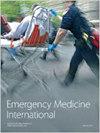Prevalence, Risk Factors, and Mortality of Patients Presenting with Moderate and Severe Hyponatremia in Emergency Departments
IF 0.8
4区 医学
Q3 EMERGENCY MEDICINE
引用次数: 0
Abstract
Background. Hyponatremia is among the most common electrolyte disturbances encountered in clinical practice and is associated with a high rate of morbidity and mortality. However, there are very limited data on adult cases presenting to emergency departments with hyponatremia. Objectives. This study aimed to evaluate the frequency, clinical characteristics, and outcomes in hyponatremic patients presenting to emergency departments. Methods. This retrospective study analyzed all patients older than 18 years who visited our institution’s emergency department between October 2018 and October 2019 and has a serum sodium (Na) level <130 mmol/L. Results. Among 24,982 patients who visited the emergency department and had a documented serum sodium level, 284 were included. Patients’ median age was 67.13 ± 14.8 years. Younger patients are less likely to develop severe hyponatremia compared to older patients (adjusted odds ratio (AOR): 0.415; 95% confidence interval (CI): 0.231–0.743; ). Asymptomatic hyponatremia and gastrointestinal manifestations were the most common presenting hyponatremia symptoms (33.7% and 24.2%, respectively). Proton pump inhibitor (PPI) use, angiotensin-converting enzyme inhibitor/angiotensin receptor blocker (ACE/ARB) use, and spironolactone use (OR = 2.6 and 3.9, 2.3 with a , 0.03, and 0.05, respectively) were associated with increased odds of severe hyponatremia. There is no difference in the overall mortality rate within 6 months of presentation between severe and moderate hyponatremia groups (11.1% versus 16.2%, ). Conclusion. Moderate and severe hyponatremia are not uncommon among patients presenting to emergency departments. Moderate hyponatremia can be asymptomatic with clinical significance. Older patients, use of PPI, use of ACEi/ARBs, and spironolactone use were associated with an increased risk of severe hyponatremia compared to moderate. Further prospective analysis of a larger population is needed to confirm our findings.急诊科中度和重度低钠血症患者的患病率、风险因素和死亡率
背景。低钠血症是临床上最常见的电解质紊乱之一,发病率和死亡率都很高。然而,有关成人低钠血症急诊病例的数据非常有限。研究目的本研究旨在评估急诊科低钠血症患者的发病频率、临床特征和预后。方法。这项回顾性研究分析了2018年10月至2019年10月期间到我院急诊科就诊的所有18岁以上、血清钠(Na)水平为<130 mmol/L的患者。研究结果在 24982 名到急诊科就诊并有血清钠水平记录的患者中,有 284 人被纳入其中。患者的中位年龄为 67.13 ± 14.8 岁。与老年患者相比,年轻患者发生严重低钠血症的几率较低(调整后的几率比(AOR):0.415;95% 置信区间(CI):0.231-0.743;)。无症状性低钠血症和胃肠道表现是最常见的低钠血症症状(分别为 33.7% 和 24.2%)。使用质子泵抑制剂(PPI)、血管紧张素转换酶抑制剂/血管紧张素受体阻滞剂(ACE/ARB)和螺内酯(OR = 2.6 和 3.9,2.3,a , 0.03 和 0.05)与严重低钠血症的几率增加有关。重度和中度低钠血症组在发病后 6 个月内的总死亡率没有差异(11.1% 对 16.2%)。结论在急诊科就诊的患者中,中度和重度低钠血症并不少见。中度低钠血症可无症状,但有临床意义。与中度低钠血症相比,老年患者、使用 PPI、使用 ACEi/ARBs 和使用螺内酯与重度低钠血症的风险增加有关。要证实我们的研究结果,还需要对更多的人群进行进一步的前瞻性分析。
本文章由计算机程序翻译,如有差异,请以英文原文为准。
求助全文
约1分钟内获得全文
求助全文
来源期刊

Emergency Medicine International
EMERGENCY MEDICINE-
CiteScore
0.10
自引率
0.00%
发文量
187
审稿时长
17 weeks
期刊介绍:
Emergency Medicine International is a peer-reviewed, Open Access journal that provides a forum for doctors, nurses, paramedics and ambulance staff. The journal publishes original research articles, review articles, and clinical studies related to prehospital care, disaster preparedness and response, acute medical and paediatric emergencies, critical care, sports medicine, wound care, and toxicology.
 求助内容:
求助内容: 应助结果提醒方式:
应助结果提醒方式:


